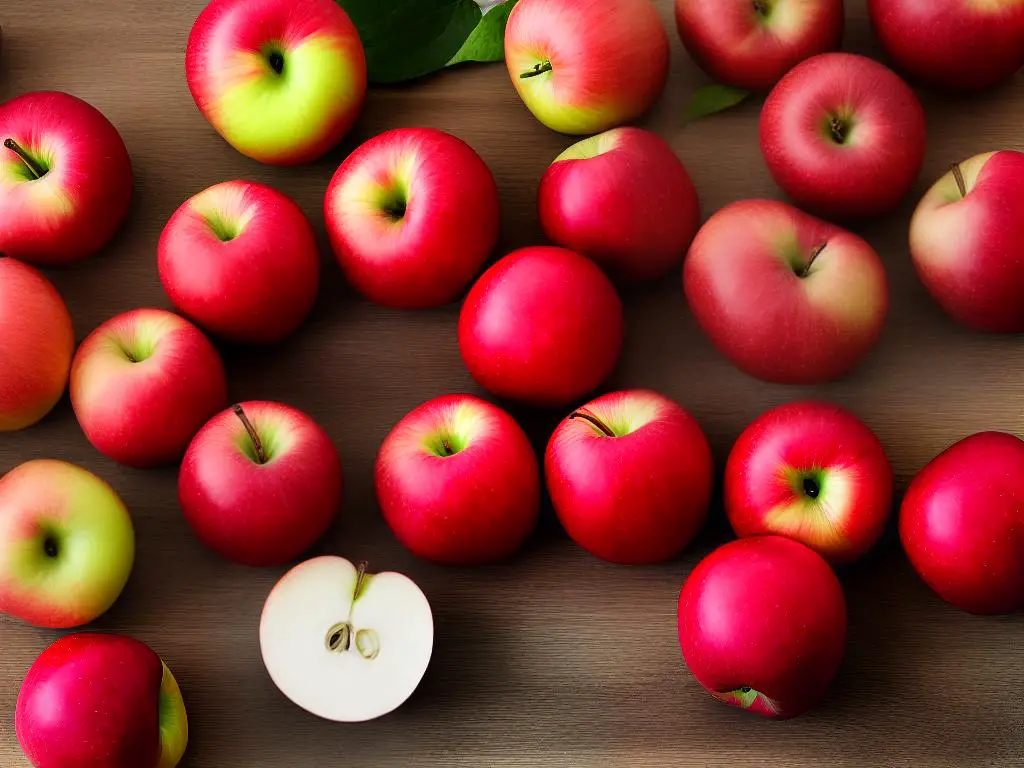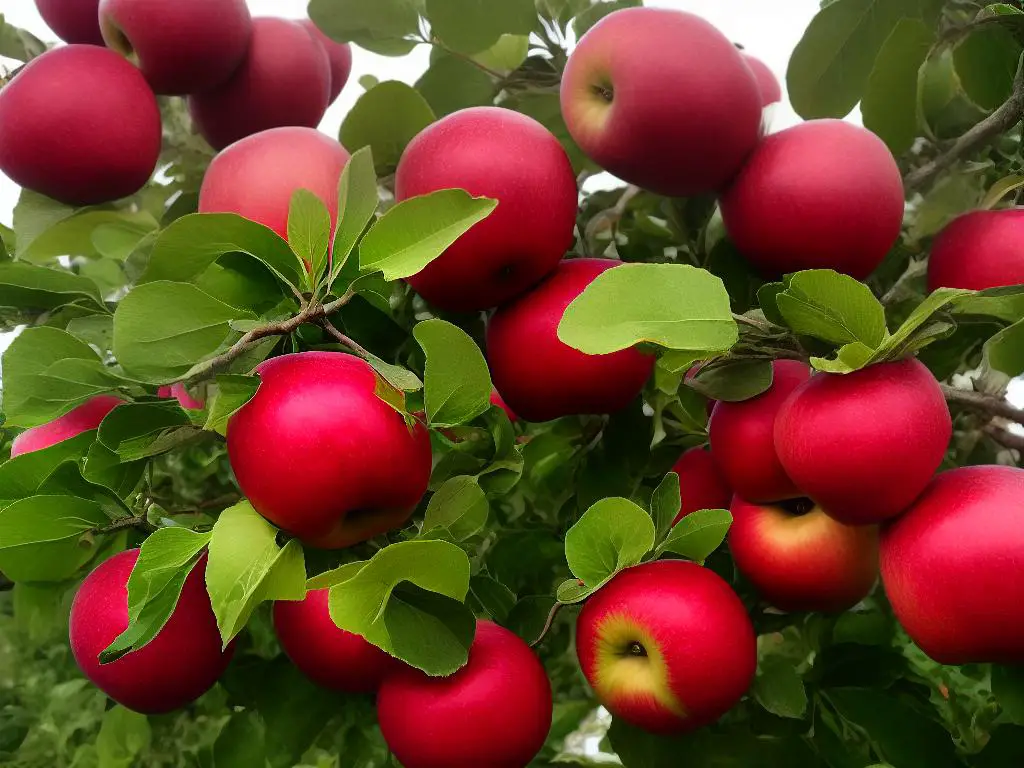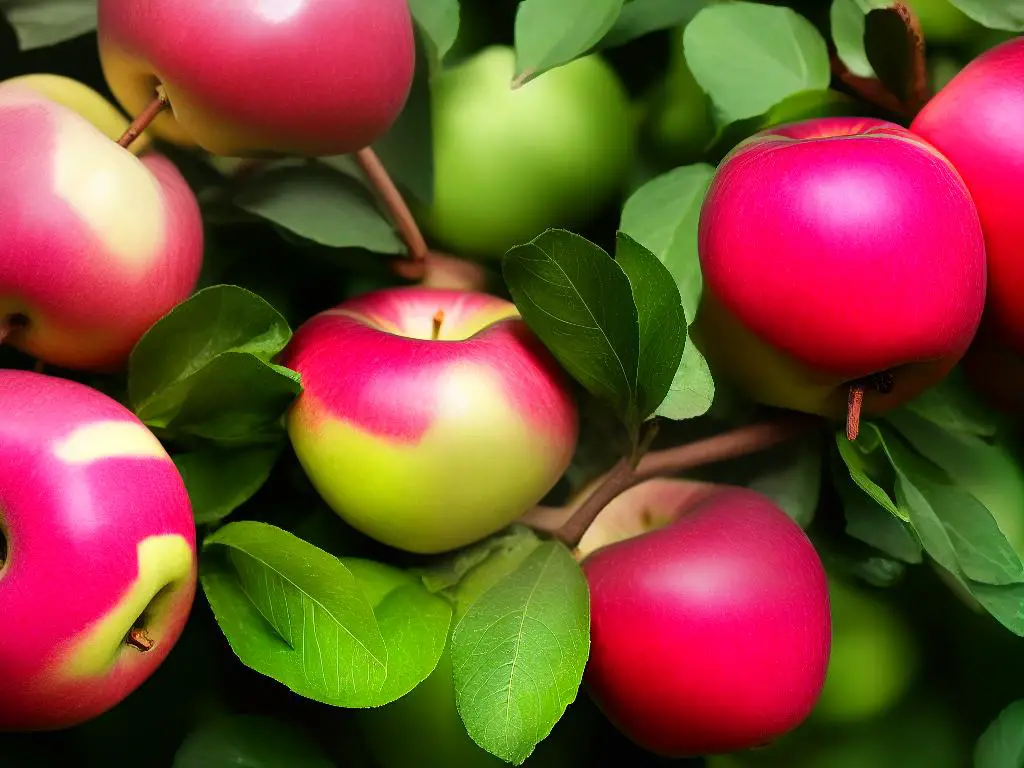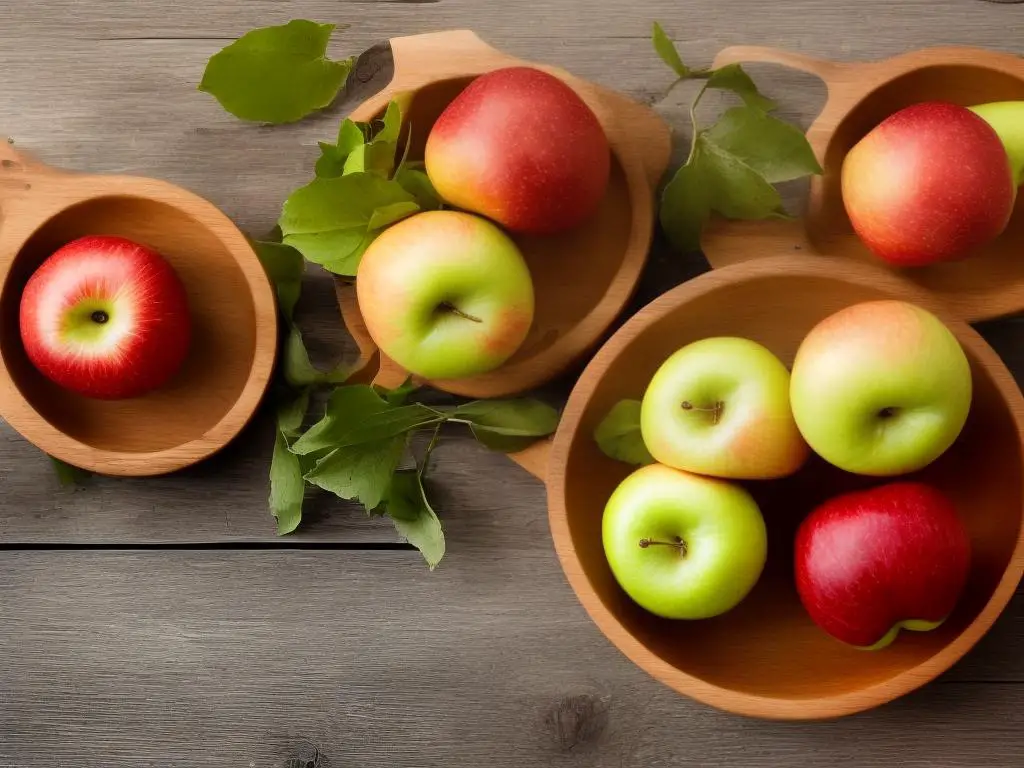In the vast world of fruit, one particularly unique variety stands out – the Lucy Rose Apple. This apple variety, with its deep crimson hue and delightful flavor, has carved out a noteworthy place in the realm of apples. The history of Lucy Rose apples and their development is a fascinating journey that transcends across various geographical locations. Not just visually appealing, these apples also promise significant benefits to human health, making them an excellent addition to any diet. Furthermore, they can be incorporated into a variety of recipes, enhancing the flavors of various dishes. This comprehensive guide aims to provide a detailed exploration of Lucy Rose Apples; from its historical background and characteristics to health benefits and cultivation methods.
Lucy Rose Apples: Historical Background and Characteristics
Lucy Rose Apples: The Emergence of a Modern Apple Variety
Lucy Rose Apples, also known as Lucy™ Rose, are a relatively modern apple variety hailing from Minnesota, USA. This apple cultivar is a double cross between ‘Honeycrisp’ and a variety of ‘Koralle’ flowering crabapple. This peculiar crossbreeding process is a testament to the innovative spirit of its breeder, the University of Minnesota. The creation of the Lucy Rose Apples was initiated in 1998, and it was not until 2014 that the newly formed apple cultivar was named and introduced commercially into the market.
Introducing the Colorful Lucy Rose Apples
Emerging from the colorful camp of apple varieties is the Lucy Rose Apple, deriving its name from its enchanting rose-like hue. This unique apple is not just a visual treat with its vibrant red skin overlaying a green-yellow background but a gustatory delight as well, thanks to its parentage— the flavorful Honeycrisp and pink-red fleshed Koralle varieties. Indeed, the blend of hues and flavors makes this apple a standout among the crowd.
With its taste that strikes a perfect balance between tart and sweet and has distinct notes of berries, the Lucy Rose apple wins over both apple and general fruit lovers. Its juicy texture gives it top ranking in taste tests, affirming its appeal to a wide audience.
What’s more, the Lucy Rose apple offers an enjoyable mouthfeel, thanks to its honeycrisp-like, firm, and crisp flesh. This makes every bite exciting and satisfying, complementing its already intriguing taste profile. Its late season harvest, beginning typically in October, and impressive shelf life, which can extend over several months, round out its appealing characteristics.
On the whole, the Lucy Rose Apples are a delightful medley of beautiful appearance, intriguing taste, and satisfying texture, setting them apart from their peers. They also bear testament to human innovation in agriculture with their intriguing cultivation and unique genetic background.

Health Benefits of Lucy Rose Apples
The Nutritional Powerhouse: Lucy Rose Apples
The sensory appeal of Lucy Rose apples, from their pink-tinted skin and flesh to their perfectly balanced sweet and tart taste, have no doubt captured the imaginations of fruit enthusiasts since their introduction by Washington’s Tree Top Orchards in 2019. However, their allure does not end there.
These vibrant apples are as nutritious as they are beautiful. A medium-sized Lucy Rose apple, for example, contains about 95 calories, mostly from carbohydrates, making it an excellent energy booster. Adding to their health benefits is their dietary fiber content — about 4 grams per serving. This not only aids in digestion but also helps control blood sugar levels and promotes satiety. As a result, these apples may contribute to weight management, underscoring their importance as a staple for the health-conscious consumer.
Vitamins: A Crucial Player in Lucy Rose Apples’ Nutritional Team
Lucy Rose apples are packed with Vitamin C – a potent antioxidant vital for your immune system’s health. A single medium apple can meet approximately 14% of your daily Vitamin C needs. This apple variety also contains traces of other vitamins such as Vitamin A, essential for eye health, and several B-complex vitamins that support metabolic functions.
Minerals: The Unsung Heroes of Lucy Rose Apples’ Nutrient Composition
Lucy Rose apples not only boast vitamins but also offer a variety of essential minerals. They are a good source of potassium, which supports heart health, and also have small amounts of other minerals like calcium, magnesium, and manganese.
Trace Elements: Every Little Nutrient Counts
These red-toned apples contain trace quantities of iron, zinc, and copper, which, while required in small amounts by the body, play significant roles. Iron is integral for hemoglobin production, zinc boosts immunity and aids in cell division, and copper helps with red blood cell formation and iron absorption.
Lucy Rose Apples: Beyond Basic Nutrition
The health benefits of Lucy Rose apples are not simply confined to macro and micronutrients. They are also rich in natural antioxidants called flavonoids, specifically quercetin. This compound has anti-inflammatory and antiviral properties and may help protect against heart disease and certain types of cancer.
Lucy Rose Apples: A Powerhouse of Immunity Boosters
Whether you bite into a Lucy Rose apple or sip it as a refreshing juice, you’re not just quenching your thirst or staving off hunger. This particular apple variety also helps enhance the body’s immunity due to its Vitamin C content. It assists in the production of collagen, which aids in wound healing as well as maintaining skin health.
Lucy Rose Apples: A Delectable Fruit Loaded with Nutrients
Not only do Lucy Rose apples captivate the senses with their visually appealing aesthetics, they are also a vital source of essential nutrients. Packed with crucial vitamins, minerals, fiber, and antioxidants, these apples offer a delicious way of maintaining a balanced and healthy diet.

How to Grow Lucy Rose Apples
Diving into the Fascinating Journey of Cultivating Lucy Rose Apples
Also referred to as Lucy Apples, Lucy Rose Apples have gained recognition for their striking pink flesh and the multi-tonal appeal of their skin. A delightful blend of sweetness and tartness characterizes their flavor. Brought to life by the University of Minnesota through an apple breeding program which involved cross-breeding a Honeycrisp with an unnamed apple variety, this variety is truly one-of-a-kind.
Admirers of this refreshing fruit often look forward to October, the late apple season, for the ripening of Lucy Rose Apples.
Growing these rare specimens isn’t everyone’s piece of cake, given the intensive care and attention they demand. Unlike their common counterparts, Lucy Rose apples necessitate a rigorous cultivation protocol right from nurturing saplings to reaping mature apples, making them a less common sight.
Planting Lucy Rose Apples
To ensure the successful growth of Lucy Rose apple trees, choosing the suitable location is paramount. Like most apples, Lucy Rose apple trees flourish optimally in a sunny, well-draining location. Ensure the selected spot gets full sun as apple trees need ample sunlight to develop fruit. A spot with high cold air drainage during frosts will also aid growth.
Lucy Rose apple trees prefer loam or sandy loam soils, which should ideally be acidic to neutral, with a pH range of 6.0 – 7.0. It is crucial to prepare the soil prior to planting. Incorporating well-rotted compost or manure can improve soil fertility and water retention properties.
The best time to plant the apple saplings is in late winter or early spring when the trees are dormant. Ensure the soil is not frozen at the time of planting.
Dig holes that are broad and deep enough to accommodate the tree’s root system. The components of the Lucy Rose apple rootstock should be situated slightly above the soil surface after planting.
Maintenance and Care for Lucy Rose Apples
After successfully planting your Lucy Rose apple trees, proper care and maintenance are necessary to achieve optimum growth. The trees should be watered routinely, especially during dry periods, but avoid overwatering as it can cause root rot and other fungal diseases.
Pruning is an essential part of apple tree care, and this holds for Lucy Rose Apples as well. It aids in maintaining the tree’s shape, invigorates growth, and improves air circulation. Pruning should be carried out when the tree is dormant, usually late winter or early spring.
Regular inspection for pests and diseases is crucial. The most common pests that affect apple trees are apple maggots and codling moths, while common diseases include apple scab and fire blight. In case of any infestation or disease, consulting a local extension service for control measures is advisable.
About Harvesting Lucy Rose Apples
Lucy Rose Apples, a unique and distinct apple variety, are typically ready for harvesting in October. Upon ripening, they transition from a shade of green to an entrancing mix of yellow and red hues. The readiness of these apples for harvest can be gauged by observing their color, size, and flavor. If they detach effortlessly from the tree, it signals that they are prime for picking.
Post-harvest, these apples can be stored in a cool, dark position for about two weeks. The crisp texture and vibrant flavor of Lucy Rose Apples are best preserved under cold conditions.
Though the nurturing and care of Lucy Rose Apples might be somewhat challenging compared to other varieties, the delightful reward of biting into this singular, robust, and nutritious fruit makes the effort truly worthwhile. Hopefully, these guidelines provide you with the necessary knowledge to embark on your own journey of cultivating these remarkable apples.

Recipes and Uses for Lucy Rose apples
Culinary Adventures with Lucy Rose Apples
In the culinary world, Lucy Rose apples, renowned for their bright pink interior, are a sight to behold. Their appealing hue remains even after cooking, making them a visually stunning addition to any recipe. This hybrid variety, stemming from their ancestor, the Honeycrisp apple, possesses the unusual yet enticing combination of sweet and tart flavors. Paired with their firm texture, these apples become a flexible choice for numerous cooking ventures.
A Star Ingredient in Salads
Lucy Rose apples can be a veritable stand-out ingredient in a fresh salad. Their vibrant color and distinctive flavor can be perfectly showcased in a Lucy Rose Apple & Walnut Salad. Toss up lettuce, chopped Lucy Rose apples, and toasted walnuts. Top it with a vinaigrette dressing and sprinkle with blue cheese for extra depth and complexity of flavor.
Upgrade Your Sandwich
These Apples can add a refreshing punch to your regular sandwich too. Just slice the Lucy Rose apples thin, add it to a sandwich with turkey or chicken, a smear of brie, and a drizzle of honey mustard for a perfect balance of sweet, creamy, salty, and tart.
Desserts featuring Lucy Rose Apples
Lucy Rose Apples make excellent desserts due to their tart-sweet balance. Imagine a traditional apple pie but with a twist – Lucy Rose Apple Pie! The beautiful pink filling peeps through the lattice crust, making it as delightful to look at as it is to eat. Their firm texture makes them perfect for baking, and they hold up well to the heat.
Homemade Apple Sauce
Lucy Rose apples can also be cooked down to make a vibrantly colored applesauce. The applesauce can be used as a topping for pancakes, waffles, or French toast. It also works as an accompaniment with pork dishes, adding a splash of color that looks as appetizing as it tastes.
Delicious Beverages
If you’re one for interesting beverages, Lucy Rose Apples can be extracted for its juice, and left to ferment to create a vibrant, ruby-toned cider, perfect for a cozy fall evening. Alternatively, use it as an interesting twist in the classic apple martini, adding a pop of color and a tangy-sweet apple flavor.
For the Health-Conscious
Lucy Rose apples, like other apple varieties, offer a good source of essential nutrients and fiber. Whether you include them in your favorite fruit salad, juice them for a healthy drink, or eat them as a snack, Lucy Rose apples are a delightful addition to any meal and a stunning contribution to your table. Beyond the recipes above, these apples can also be added to soups, stir-fries, jams, and jellies. Their unique color and taste profile ensure they’re a standout ingredient in any dish.

In encompassing the historical background, health benefits, growth tactics, and culinary applications, we hope this guide helps you attain a thorough understanding of Lucy Rose Apples. The multifaceted uses of these apples, coupled with their health benefits, can lead to a myriad of delightful explorations in both the garden and the kitchen. So whether you plan to grow them in your backyard or use them to reinvent your desserts, the versatile Lucy Rose apple offers ample opportunities for you to broaden your fruit horizons. May it spur you on to future fruitful adventures!